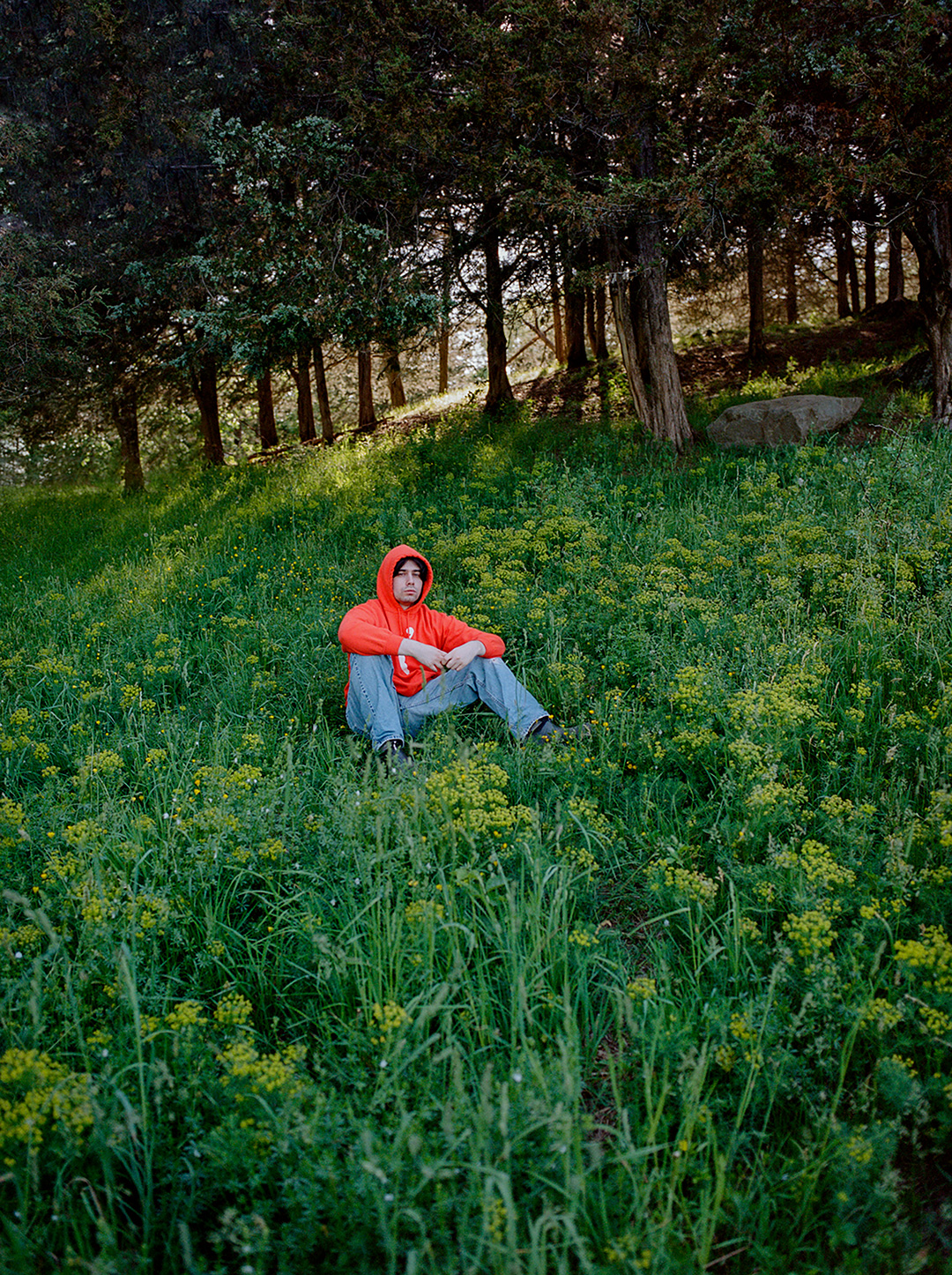
Immersive and Expansive Influences from Afar
Urner’s interest in ambient music and background music genres is longstanding, dating back to before he even knew the names of these genres. In fact, the first piece of recorded music he remembers liking laid the groundwork for this appreciation. Every night before bed, Urner’s parents would put on a cassette tape of the Om Namah Shivaya, a classic Hindu chant that they had picked up from a local ashram to help him fall asleep. Though not technically ambient music, Urner looks back at this Hindu chant and its droning, twinkly, soothing qualities as informing much of the music he makes now.
“I kind of thought [ambient music] was something I got into later, but this stuff has been in my musical subconscious since I was really young,” he reflects.
Another key musical touchstone early on for Urner was the world of video games and particularly their soundtracks. Limited to 30 minutes of playing time a day by his parents, his experience of the immersive and fantastical environments of games like World of Warcraft and Animal Crossing felt like only brief glimpses. Urner’s access to music, on the other hand, was unlimited. When his daily video game limit was reached, he would listen to the soundtracks, using his imagination to continue exploring these magical worlds.
“I wouldn’t necessarily be able to dive really deep into those worlds. But what I would have [access to] was a CD player and an iPod,” Urner remembers. “I would get really into these game soundtracks, which when you listen to them by themselves are a lot of the time basically ambient records.”
These early encounters with background music becoming the main experience were foundational in establishing Urner’s musical taste, but it was at Oberlin College in Ohio where he really developed the craft of creating this music himself. Initially, Urner started out as a music major with a focus on the rigors of ensemble composition, music theory, and contemporary avant-garde music. In his spare time, he made electronic music under the moniker Sumo Party where he found a happy medium between the Roland SP-404 sampler beat scene, ambient music, vaporwave, and gentle video game soundtrack aesthetics.
It wasn’t until Urner discovered the TIMARA (Technology in Music and Related Arts) program at Oberlin’s music conservatory that he found that there was a rich history of the formal study of electronic music. Established in 1967, TIMARA was the world’s first conservatory program in electronic music, championing the study of computer music, digital media, and new performance. Up until this point, Urner says that electronic music and classical music felt like very separate worlds. Electronic music had been a fun thing to make on the side, more a process guided by intuition rather than methodical study, while his formal coursework emphasized intentional decisions structured by music theory.
Urner made a quick pivot in his music major direction, shifting his focus into TIMARA studies. He dove into the world of electroacoustic music, live diffusion, granular synthesis, multi-channel installations, and learning the long history of ambient music. This immersion into the academic world of electronic music helped expand his toolbox of techniques for making music.
“I think that both the technical side, like the tool set that I picked up for making electronic music and the way I listen to music have been really influential,” Urner reflects.
It was also the structure of school and the pressures to create music for classes that pushed Urner to grow. With new musical concepts to explore, assignments to write for classes, and recitals to compose for, Urner had ample opportunity to experiment freely.
“I wasn’t really trying to be an [electroacoustic] composer by any means, but it was definitely very influential to be around that music,” Urner admits. “I just listened to and made a bunch of music. That never would’ve happened if I hadn’t been in that environment.”

Breakthroughs in Form and Function
But after graduation, the puzzle became how to implement his own structure to carry that momentum of consistent creation. In the beginning, Urner struggled. Without the structure of school forcing him to make music, compounded with the added dynamic of working full-time, making music in his spare time proved difficult. The difference maker came in two parts in 2020.
The first breakthrough, Urner admits, might seem silly. The change? He got a new desk. Where before, Urner would have to bring gear out of his closet and fiddle with wires to set up every time he wanted to make music, having a new desk and subsequently larger workspace allowed him to have all his music gear — namely an Elektron Octatrack, a Whimsical Raps Eurorack modular synthesizer, and a Korg microSTATION — already set up and ready to go.
“One [breakthrough] was the creative ergonomics piece,” Urner explains. “When this is all set up such that when I feel like making music all I have to do is turn two things on and open up the window on my computer and it’s just happening, I make a lot more music than if I have to plug this into that, get this out of the closet, move this around, all that.”
The second breakthrough came when he discovered a new technique with his Octatrack, a piece of gear he was on the cusp of selling after having difficulty figuring out a workflow with it that worked for him.
“At the same time, because I was playing with those instruments more, I came across this new way of thinking about sampling and looping that got me really excited about recording music and improvising. It felt really expressive,” Urner shares.
The technical change Urner discovered involved an unconventional way of using the Octatrack’s built-in looping feature to record a long loop and overdub a series of loops on top of it, creating a “scaffolding of pitches.” With this technique, Urner combined layer after layer, a note here, a note there, as if piecing together a melody in the dark by feel and intuition. Imagine at first a single note played in a loop. The next layer placed on top adds another note. And then another. Rather than writing melodies based around music theory, Urner created a structure where improvisation and play became the guiding light for his compositions.
From there, these layered loops became the samples that he would draw from, taking slices of the loops and rearranging these slices. This method afforded Urner room for both improvisatory creation and methodical arrangement.
“There’s something really pleasing to me in that interplay of the most raw, un-articulatable human things and the structured part of music that makes me think more of fractals in nature or computations,” Urner expresses. “The way that those two things interact and how messy or clean that interaction can be is exciting to me. It felt really exciting to come across a certain system of interacting with sound with these tools that was able to play with that directly.”
This new compositional formula has proved incredibly fruitful. In April 2020, he self-released Severance on Bandcamp, a short EP of the first few tracks that he felt satisfied with from this new creative process. From there, he spent the next year exploring this new way of making music, creating freely and simply enjoying the process.
Initially, Urner thought of these tracks more as a practice of refinement. But with a year’s worth of tracks, he wondered if these recordings could actually be pulled together to make an album. Around the same time, Urner stumbled upon a piece of advice through a Red Bull Music Academy interview with free jazz saxophonist Peter Brötzmann that proved to be another critical breakthrough in his thinking about making an album.
“It was really a comment in passing where he was talking about performing and improvising live. He was like, ‘The audience is half of the [performance],'” Urner recalls. “It was that little [detail] that totally tripped me up.”
Lucidity at Last
For Urner, the release process had previously felt more like a formality and an imposition rather than musical expression. Brötzmann’s advice helped him bridge that gap. An album did not have to be “finished” before it was released; it was through the release process, through its interaction with an audience, that the album would continue to take shape. From there, Urner hosted listening parties with friends, received feedback from peers, and sent demos out to labels, ultimately landing with Atlantic Rhythms, which ushered him through the rest of the release process.
“It made way more sense thinking about the release process being just as much a part of the composition process as anything else,” Urner explains. “That’s where the name of the album comes from. The idea was: each piece [of the release] is an exit; let go of these artifacts of the process, and they’re leaving. Now my part is done; the listener part starts now.”
Exits became an album that was no longer just the results of Urner’s efforts, but one built on conversation and interaction. Its tracks are not only rigorously sculpted; they also feel immensely humanistic, evolving over time as if each is its own living, breathing organism. In “Gestures,” warm, round synth tones bounce off one another like balls of light, their collisions becoming faster and faster before losing energy and fading into a lugubrious organ drone. “Heavily” moves slower — a twinkling of bright bells shimmering together, panning from the left to right, creating a sensation of spiraling upwards. Over time, the bells blend together, becoming more and more amorphous until they are just one cascading wall that eventually fades away.
Other tracks like “Save” and “When It Matters” remain a more constant drone, fading into the background. But this too was a conscious decision made with the audience in mind.
“There are these little valleys in [Exits] where I want you to be able to space out and not feel like you’re going to miss something if you don’t pay close attention, like a release of tension,” Urner elaborates.
It seems paradoxical that it was through a concerted effort to achieve a fully optimized gear set up and workflow that Urner’s music could be so organic, intuitive, and raw, but it is in this balance between the technical and the emotional that he found a space where he thrives.
“After finishing the music for this record and turning it in for mastering… I felt like I was free to experiment or explore other kinds of music I wanted to make,” Urner reflects. “And actually, I’ve stepped away from electronics a lot for the past year.”
Finding a creative process that felt so lucid, Urner has shifted his attention back to his days at Oberlin, donning pen and paper to work on contemporary classical composition. It’s an exciting new venture, particularly because he has a clearer understanding of each step in his compositional practice. The prospect of composing for ensembles featuring a mix of chamber musicians and electronic samplers is a puzzle that Urner is more than happy to try to figure out. This is a new creative chapter for Urner.
“The Urner project so far has been centered around this one way of working with sound and part of this album is: I wanted to move on to something new,” Urner says. “That part of it also was like an exit. I want [these tracks] to leave my head and be in the world so I can create space for something else.”

Ω






